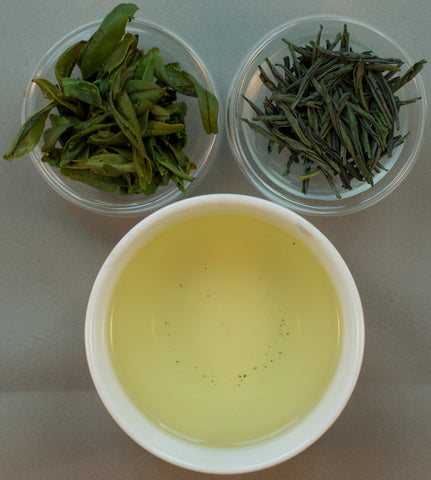Mei Cha, or “Eyebrow” tea, may as well be China’s national beverage. The style is ubiquitous and is produced in every tea-growing region of the country. The pan-fired, then rolled leaves end up looking like a curved eyebrow.
This delicious example of what mei cha should be is grown on Tai Shan, or Tai Mountain. The tea garden is near a Buddhist temple whose monk’s favor this tea.
Provenance:
-
Origin: Tai Mtn., Zhejiang China
-
Grower/Teamaster: Xu Zhao Yu
-
Harvest Date: May 2022
-
Cultivar: Qimen Xiaochuyezhong
-
Cultivation: Natural (Organic)
-
Plucking Standard: Leaf only, no bud; 6-8 leaf pluck
-
Processing Notes: Pan-roasted, stems and large broken leaves removed after rolling
-
Nickname: Buddha’s Eyebrow; this style is generally referred to as “eyebrow” tea
-
History/Pedigree: Mei cha, then known as Chunmee or Young Hyson in England, has been produced since the Qing Dynasty (1644-1911)
Brewing Suggestions1:
-
Water: 170-180˚F
-
Tea: 2g per 4oz of water (about a level 1 tsp2)
-
Steep: 1-2 minutes up to 5 times
Tasting Notes:
- Complex and robust, with the intense mineral notes the Jiu Keng cultivar is know for; aroma of malt and roasted nut
1 Brewing suggestions are just that. Try it the suggested way then experiment. In this case I suggest first experimenting with the quantity of tea per oz of water. Then experiment with the temperature, length, and number of steepings. Some tea drinkers like to use slightly hotter and longer times for each subsequent steeping. Higher temperatures usually mean a more robust liquor but I wouldn’t stray about 190˚ unless you are doing very short, sub 1 minute steeps.
2 Weighing your tea is always the best way to control your dosage. I provide approximate volume measures for convenience but they can be problematic due to the variance in tea leaf shape and size.



